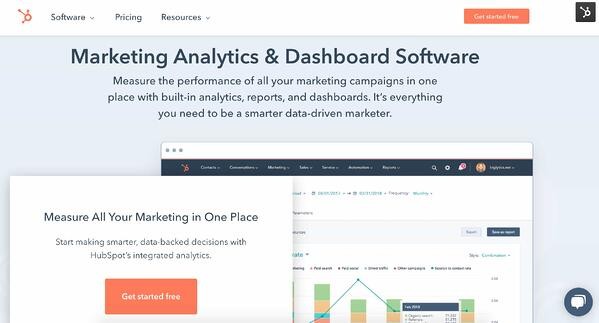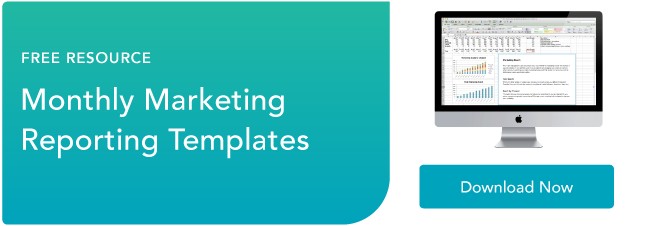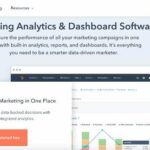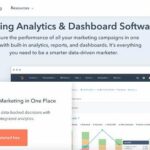Determining which parts of your marketing efforts drive conversions and sales can be one of the messiest areas of marketing. But it's also one of the most important — assuming you want to increase ROI, revenue, brand awareness, conversions, campaign success, and more.
This is where marketing attribution comes into play. In this blog post, we'll cover the definition of marketing attribution, the three main types of marketing attribution, and seven marketing attribution reporting software.
Here are four examples of the benefits of marketing attribution:
- Determine the most effective areas to focus your marketing efforts and budget.
- Understand your target audience and their needs.
- Improve your chances of reaching and resonating with your audience with personalized experiences.
- Increase ROI.
Three Types of Marketing Attribution and Software
No matter which benefit you're trying to derive from marketing attribution, there are three main categories of marketing attribution — keep these in mind when setting your attribution goals and deciding which software is ideal for you.
1. Multi-Touch Attribution (MTA)
Multi-touch attribution identifies which of many possible customer touchpoints is responsible for a sale. It’s important to realize that while most MTA programs include some channel data, they’re designed to test specific touchpoints.
For instance, a multi-touch marketing attribution tool may evaluate your touchpoints in the following ways:
- First-Touch Model: A first-touch model assigns all of the credit to the first webpage or digital asset that led a customer to your site. This model is great for understanding what brings people to your door.
- Last-Touch Model: Last-touch attribution is the inverse of first-touch. It gives 100% of the credit to the last thing a customer sees before making a purchase. This model is great for evaluating bottom-of-the-funnel content like CTAs and landing pages, but it’s not much help at the start or in the middle.
- Last-Interaction Model: The last-interaction model often overlaps with the last-touch model we just reviewed, but it differs in an important way — last-interaction modeling gives all credit to the last touchpoint that produces a conversion. For instance, in the last-touch model, the final blog post a customer viewed would get the credit, whereas it would not in the last-interaction model.
- First-and-Last Model: Unlike the three prior models, the first-and-last attribution framework splits the credit. Automation platform Ontraport recommends this model because the first and last touchpoints tend to stick out in a customer’s mind.
- Simple-Decay Model: This model gives the most credit to the last touchpoint and progressively less to prior ones. The question is whether those weights correspond accurately to the customer’s experience.
Any attribution model is better than none. However, MTA models can contain gaps and undue assumptions. For example, a customer might have seen a television ad or received a friend’s recommendation that digital tracking could not account for.
Multi-touch attribution is also getting more difficult thanks to platform restrictions. Google, Amazon, and Facebook — the three largest ad networks — have placed limitations on cross-platform tagging. Pixel-based solutions face similar limitations due to Mozilla and Apple’s past browser updates, which eliminate tracking pixels for speed and security reasons.
2. Marketing Mix Modeling
Marketing (or media) mix modeling takes a more difficult approach than MTA. Rather than using a tag or pixel to follow the individual user around the web, MMM uses multivariate regressions to predict how much of an impact certain sales and marketing tactics had on customer behavior.
A top-down model, MMM takes into account historical data from online and offline sources. It attempts to account for external influences, such as seasonality, pricing data, and broader economic conditions. MMM is popular at enterprise companies — and because it requires a boatload of data and complex algorithms, the space is somewhat dominated by enterprise vendors with roots outside of marketing.
3. Multi-channel Attribution (MCA)
Multi-channel (sometimes called cross-channel) attribution is a blend of the MTA and MMM camps. Multi-channel attribution uses individual-level data, but it attempts to evaluate certain tactics, like marketing mix modeling.
MCA seeks to paint a full picture of how a consumer’s online and offline activities lead to the sale. In the simplest MCA model, any channel that the customer accessed en route to the sale gets the credit.
If a customer searches for a product via desktop, reads a blog post on mobile, visits a physical store, and then finally purchases after a social media referral, each channel gets weighted credit depending on the amount of time that user spent on it.
Tools like tracking pixels allow marketers to evaluate channels like search, social media, and ad retargeting. Additionally, people-based attribution techniques tie channel and touchpoint data to individual customers.
Today, the challenge is connecting customers’ online and offline behavior. How can you do it? Here are four techniques:
- Foot Traffic: Mobile marketing companies use beacon technology — or, in Foursquare’s case, decision-making engines — to determine where smartphone users are. Mobile device IDs are then matched with customer profile data to give credit to certain campaigns.
- Point-of-Sale Data: When a user makes a credit card purchase at a physical location, the credit provider works with a data company to give credit for the purchase to prior channels.
- Customer Panels: Some companies ask users to opt-in via an app that transmits data about their location or offline behaviors back to the marketing team.
- Multi-Source Matching: Simply looking at a purchase, a location, or declared data won't tell you the whole story. That's why companies that invest in MCA cross-check data for the an accurate picture of which offline channels a customer might have engaged with. For example, companies can use point-of-sale data to begin tracking customer behavior and use those numbers to influence a future campaign.
Now, let's dive into seven examples of marketing attribution software to help you with attribution reporting, analysis, and more.
1. HubSpot Marketing Analytics Software & Dashboard
HubSpot's Marketing Analytics & Dashboard software measures and analyzes the performance of your campaigns and marketing efforts with built-in analytics, reports, and dashboards. With HubSpot, all of your CRM data and Marketing Software data are located in one place, at your fingertips — no SQL or coding required. This allows you to identify, review, organize, and share your marketing attribution data (among many other types of data) from your all-in-one CRM platform with ease.
HubSpot offers granular Attribution Reporting for Contact Attribution and Revenue Attribution.
In terms of Contact Attribution Reporting, each customer interaction — and any revenue generated from that interaction — is recorded in that contact's record. This is also helpful because it helps ensure everyone is getting credit for their work.
As for Revenue Attribution Reporting, you can pinpoint the specific channels that are hitting or surpassing their goals — and which channels need improvement — this way, you can identify the areas in which you should focus your attention and budget.
In addition, HubSpot has some other notable features that have the power to make marketing attribution reporting— and other marketing work and reporting — simple.
There's a Custom Report Builder which brings together all of your data so you can access contact, company, and deal data plus your landing page, blog, and email data, all in one place. Custom Objects are available to provide data that's unique to your business in order to create new segments and create custom reports, campaigns, and workflows.
Reporting dashboards are customizable and flexible — they have pre-built, drag-and-drop templates that you can share from HubSpot or via email or Slack. (You can also create dashboards from scratch if you prefer.)
Behavioral Events track custom interactions that are unique to your business and indicate when a customer is ready to move to the next stage of the buyer's journey. Lastly, Account Based Marketing (ABM) closes the gap between Marketing and Sales so you're able to close more high-value target accounts.
2. Ruler Analytics
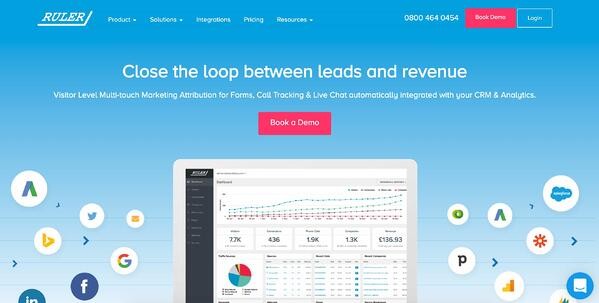
Ruler Analytics is a marketing attribution and call tracking software — it has closed-loop marketing attribution, meaning it gives you access to all of your revenue and conversions in a single location.
This multi-channel marketing attribution platform comes with online and offline conversion tracking to help you determine the return on ad spend (ROAS), identify which campaigns, channels, and keywords are leading to conversions, and get a better understanding of your customer journey.
Compare various rule-based models including first click, last click, and linear attribution. You can also map your customer journey to identify the marketing channels that are causing visitors to find your business, make purchases, and convert in other ways (e.g. complete an online form or chat with a sales rep).
You can pull customer data from any form submission and automatically match it to the marketing source it came from. Integrate your data with Google Analytics using Ruler's Google Analytics and Google Adwords integration, and upload your marketing attribution.
3. Branch
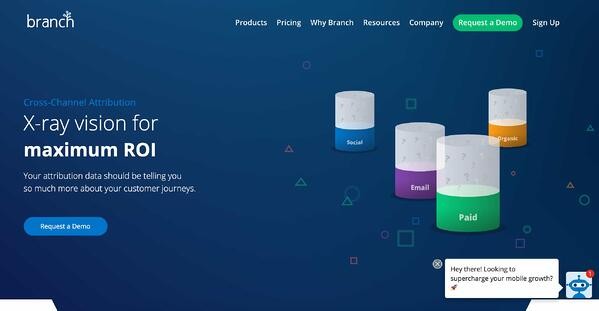
Branch is a cross-channel attribution and mobile linking platform that offers insight into all of your team's marketing efforts. The tool connects customer touchpoints from all of your channels with conversions that occur on any platform.
The tool's Predictive Modeling feature is anonymous and uses historical attributions to identify accurate attribution when there's no universal ID — this is helpful because, "Apple killed the IDFA." The IDFA was an identifier for advertisers that worked in a similar way to tracking cookies on browsers.
Branch also tracks referral and ads attribution as well as measures email, web, and social media marketing success. Use cross-platform, cross-channel cohort analysis for comparisons of all of your marketing campaigns and compare attribution across all of your channels including email, ads, social media, and web.
Branch displays your data on analytics dashboards and segments that data by device, platform, channel, campaign, conversion events (e.g. installs), or metrics (e.g. clicks).
4. Active Campaign
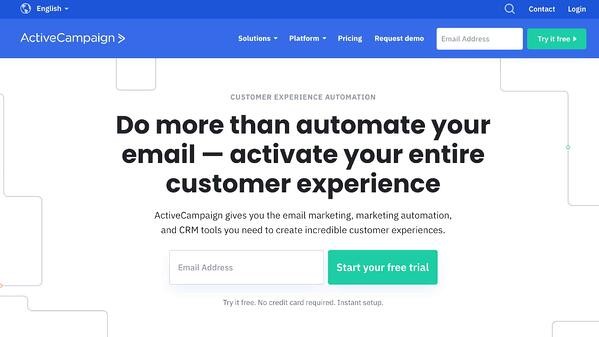
ActiveCampaign is a customer experience automation platform with attribution reporting capabilities. ActiveCampaign's Attribution Reporting allows you to identify which traffic sources and touchpoints make your leads convert.
The tool's contact records include lists that are updated with all conversions a contact makes and the specific touchpoints that played a role in that conversion. There's a Segment Builder that tells you which traffic source (e.g. ad or campaign) a contact who converted actually visited your website from.
You can set up automatic triggers to take actions once a contact has converted in a specific way, as well as create attributed values for your conversions. For instance, if one in 10 customers who completes the web form on your landing page spends $500, you may set the attributed value for a web form conversion as $50.
Use ActiveCampaign to identify attribution from a wide range of traffic sources that are both paid and organic. In terms of paid touchpoints, ActiveCampaign can help you track Facebook Ads, AdWords, and more. As for organic touchpoints, ActiveCampaign can help you track product reviews on 1) any site aside from your own, 2) blog posts by guest contributors, 3) social media posts, or 4) a response on Quora.
Set up a two-way sync between HubSpot and ActiveCampaign with the integration.
5. C3 Metrics
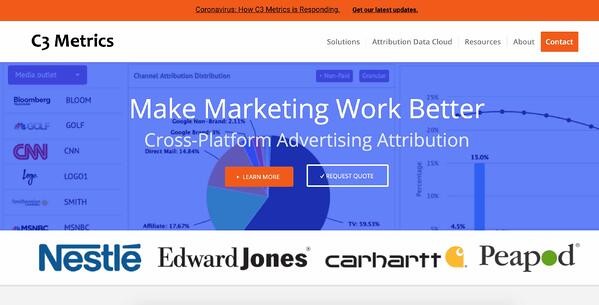
C3 Metrics is an attribution reporting tool that focuses on enterprise cross-platform advertising attribution. The tool offers attribution solutions for businesses across a range of industries including ecommerce, automotive, financial services, pharma, and travel. Additionally, there's the C3 Metrics Attribution Data Cloud that works across digital, TV, radio, and direct mail.
Use the tool's Marketing Mix Modeling (MMM) which considers external factors, such as competition or changing industry trends, when pulling attribution data. You can also connect users anonymously cross-device and cross-platform with ease, and analyze attribution with online reporting dashboards and offline reports that can be delivered when you want them.
6. Windsor.ai
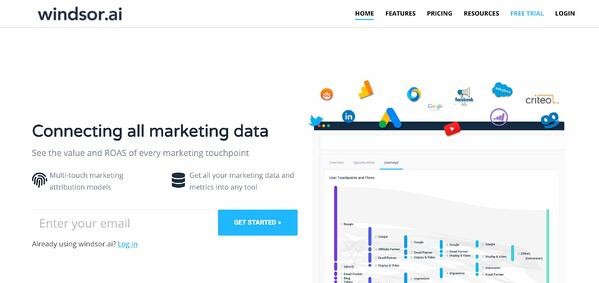
Windsor.ai is a multi-touch marketing attribution software that integrates all of your marketing data and metrics and runs attribution models. The tool measures ROI from attribution across multiple channels, campaigns, and keywords.
Multi-touch attribution modeling maps and optimizes the customer journey and determines how and where you should be spending your budget. Windsor.ai also provides your(ROAS) for all touchpoints by combining multi-touch attribution with customer journey data that's matched to cost-data.
Use the Keyword Optimization tool, Google Ads Optimization tool, and the TV Ads Performance tool to enhance all of different channels and touchpoints for your unique target audience. You can also access and pull marketing and CRM data from any tool with one of Windsor.ai's many integrations and APIs.
7. Attribution
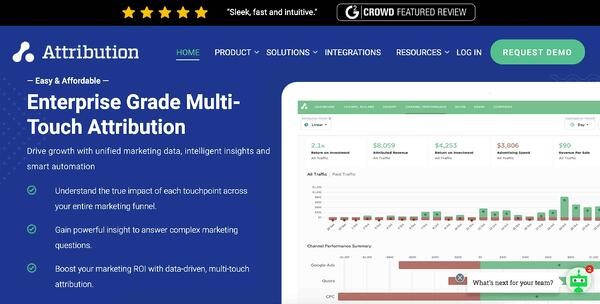
Attribution is an enterprise multi-touch attribution software that identifies the specific impact of your marketing funnel's touchpoints. There are features ideal for both B2C marketers looking to optimize marketing ROI and B2B marketers looking to streamline the path to purchase. The tool's automated data collection feature organizes all of your online and offline touchpoints and combines that information with your budget spend.
Use this tool to manage affiliate marketing, report on and improve partner performance, and compare affiliate performance to the performance of your other marketing touchpoints and channels. You can also build automated attribution models with machine learning algorithms that surface any patterns in your data and touchpoints.
Use Attribution's dashboards and reports to segment your data by campaign, touchpoint, or channel, and sync all of that data to your other software (e.g. CRM, marketing tool, business intelligence tool).
Get multi-touch attribution for HubSpot with the Attribution integration.Determine what your marketing attribution goals are, what types of reports would be most helpful for your business, and begin using one of the many marketing attribution tools available today to grow better with data-driven marketing.
Editor's note: This post was originally published in December 2019 and has been updated for comprehensiveness.

